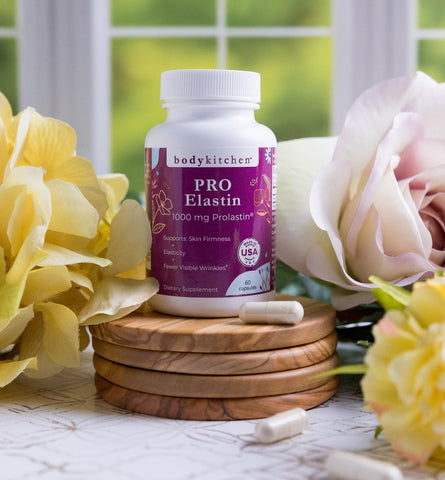The Mineral Deficiency That Hurts Women Most
Magnesium may just be the easiest and most natural way to snap out of a funk, lift your mood and keep your brain sharp as you age.
The common mineral found in spinach, zucchini and pumpkin seeds has been at the center of incredible scientific research bringing to light its vital role in mood and cognition.
Women especially appear to benefit from magnesium’s neuroprotective prowess compared to men, and older women gain the most, according to a large study of adults aged 40-73.* Researchers believe this may be due to the mineral’s unique anti-inflammatory properties.
Remarkably, study participants who consumed more than 550 mg of magnesium daily were shown to have a ‘brain age’ that is roughly one year younger by age 55 than someone who consumes 350 mg of magnesium daily.
Magnesium Benefits Your Brain and Everything Else
Often taken for granted as being a common nutrient, this do-it-all mineral is complex and highly reactive. It’s involved in over 300 metabolic reactions and acts as the spark that ignites 24/7 processes that support your health in noticeable and imperceptible ways:
- Bone health
- Heart health
- Mood regulation
- Muscle relaxation
- Energy production
- Sleep quality
- Inflammation control
- DNA repair
- Blood sugar balance
So then why are most of us not getting enough magnesium in our daily diets?
Up to 75% of U.S. Adults are Magnesium Deficient
It’s a startling statistic, especially in a modern country as food abundant as ours. But there are many factors contributing to our widespread magnesium deficiency. One of them, as health experts point out, is not the amount of food that’s available, but the quality.
If you’re regularly eating spinach, kale, zucchini, pumpkin seeds, cashews, black beans and other magnesium-rich foods, you’re probably getting enough. But “regularly” is the operative word, and a sprinkle here and bite there is not going to cut it.
Another factor contributing to inadequate intake of magnesium is that the recommended dietary allowance (RDA) is too low to begin with, which many health and nutrition experts suggest is the bare minimum to remain “disease free”.
Many women in modern societies consume a mere 240 mg of magnesium daily – far below the too-low RDA.
Magnesium Levels Can Also Be Depleted
Equally as important as being mindful about increasing magnesium intake levels is knowing how to reduce magnesium depletion.
Your body can only benefit from the magnesium it absorbs. But certain substances and conditions can lead to mineral malabsorption. Chronic digestive issues, unmanaged and sustained levels of oxidative stress and inflammation, obesity, and certain metabolic issues can affect the amount of magnesium available for absorption and use.*
Additionally, certain medications can disrupt magnesium absorption, such as antacids, antibiotics, and even the “wrong” kind of magnesium supplement.
Types of Magnesium Supplements
Most of us could benefit from having a good quality magnesium supplement in our daily put-health-first routine. Magnesium supplements come in a variety of forms, but you have to look closely at the label to see the type.
As with all minerals, magnesium cannot be processed and used by the body without being bound to an absorption agent. Pairings may include amino acids, salt, organic materials, and even oxygen. And the absorption agent that magnesium is partnered with has an effect on how the magnesium functions in your body.
Here’s a magnesium cheat sheet to help you select the magnesium supplement that’s right for your needs:
|
Magnesium oxide |
Made up of magnesium and oxygen. Common and affordable form of magnesium. Not easily absorbed compared to other forms. |
|
Magnesium citrate |
A magnesium salt made up of magnesium and citric acid. In high doses, works as a laxative by drawing moisture into the intestine. Known to support sleep and relaxation. Well absorbed by the gut. |
|
Magnesium carbonate |
A salt form containing magnesium, carbon and oxygen. Often used in over-the-counter antacids. Not ideal for magnesium intake due to low solubility and slow absorption. |
|
Magnesium malate |
Combines magnesium with malic acid, a fruit acid. Superior absorption Gut friendly. Supports whole body health including mood, muscles, heart and energy. |
|
Magnesium glycinate |
Combines magnesium with glycine, an amino acid. Highly absorbable. Well-tolerated by the digestive system. Supports sleep, mood and muscle relaxation. Helps reduce stress, anxiety and muscle tension. |
|
Magnesium l-threonate |
Combines magnesium with threonic acid, a vitamin C metabolite. High bioavailability Gentle on the digestive system. Crosses the blood-brain barrier. Ideal for promoting brain function and cognition.
|
And, there’s one form of magnesium that you absorb through your skin, not your stomach: magnesium sulfate, also known as Epsom salt. For a calming soak that relaxes muscles and melts away tension, pour the salt crystals directly into a warm bath.
Magnesium supplements are available in tablets, capsules, drink powders and salts. With so many options to choose from, it’s easy to boost your levels and meet your brain and body’s nutritional needs.
For a fruity punch of magnesium, try our cool and refreshing Hibiscus Pomegranate Spritzer. Hibiscus flower is loaded with antioxidants and pomegranate contains naturally occurring magnesium.
















